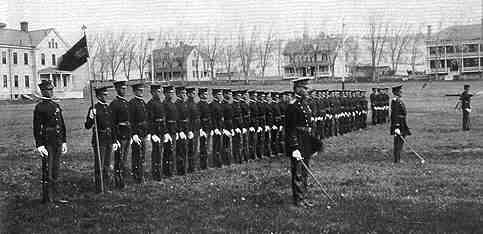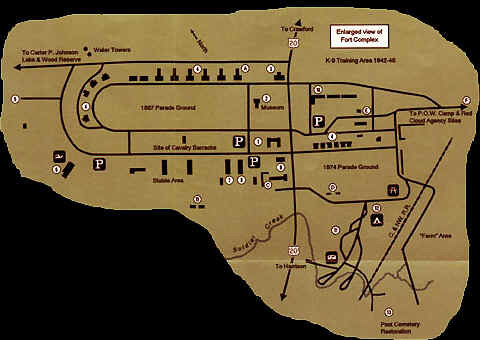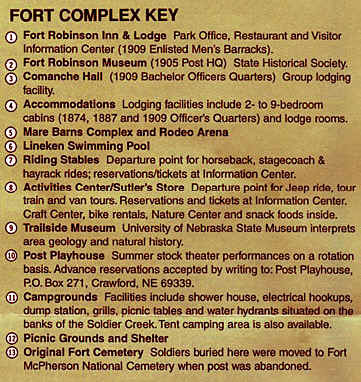 |
Indian Wars: Fort Robinson |
 |
Indian Wars: Fort Robinson |
14th Infantry Frontier Posts & Assignments
Fort Robinson, Nebraska
 |
Our thanks to Wikipedia for the following information (http://en.wikipedia.org/wiki/Fort_Robinson):
In August 1873, the Red Cloud Agency was moved from the North Platte River to the White River, near what is now Crawford, Nebraska in the northwest corner of the present-day state. The following March, the U. S. Government authorized the establishment of a military camp at the agency site. Home to some 13,000 Lakotas, some of them hostile, the Agency was a source of tension on the Great Plains.
The camp was named Camp Robinson in honor of Lt. Levi H. Robinson, who had been killed by Indians while on a wood detail in February. In May, the camp was moved 1.5 mi (2.4 km) west of the agency to its present location; the camp was renamed Fort Robinson in January 1878. Fort Robinson played a major role in the Sioux Wars from 1876 to 1890. The Battle of Warbonnet Creek took place nearby in July 1876. Crazy Horse surrendered here with his band on May 6, 1877. On September 5 that year, he was fatally wounded while resisting imprisonment. A historic plaque marks the site of his death.
In January 1879, Chief Morning Star (also known as Dull Knife) led the Northern Cheyenne in an outbreak from the agency. Because the Cheyenne had refused to return to Indian Territory, where they believed conditions were too adverse for them to survive, the army had been holding them without adequate food, water or heat during the severe winter to try to force them into submission. Soldiers hunted down the escapees and killed most over the next several weeks. The event marked the end of the Sioux and Cheyenne Wars in Nebraska.
Fort Robinson Map
 |
 |
We thank the following sources for their help and for sharing their materials and information:Thanks to the Fort Robinson Museum, P.O. Box 304, Crawford, Nebraska 69339
Copies of the Written Documentaries from the "Greasy Grass" publication of events and personnel of the 14th Infantry were provided by Thomas Buecker, Curator of the Fort Robinson Museum, PO Box 304, Crawford, Nebraska. We thank Mr. Buecker and our Historian, Bob Wilson, for their time in researching this material for us.
Our thanks to The Nebraska Game & Parks Commission & the Fort Robinson Museum for sending us their material
14th Infantry Officers at Ft. Robinson
Who Really Killed Crazy Horse?
Soldiers seldom achieved the fame of their officers, and most remained obscure or almost unknown. One such solider is Private William Gentles who was part of Gen. Johnston's army sent to keep an eye on the Mormons in 1857, and later killed the famous Indian chief Crazy horse.
Private Gentles was probably born in Ireland September 28, 1828, and entered the U.S. in 1856, perhaps illegally. He served in Co. K, 10th Infantry from 1856-61, entering Utah as part of Johnston's Army. During the Civil War he served in various Missouri units, from early 1862 to July 1865. In June 1867 he enlisted in Co. F, 14th Infantry which eventually brought him to Fort Douglas. His unit was ordered to Fort Robinson, Nebraska in 1877, where Pvt. Gentles was absent from his appointed place of duty and subsequently punished by a Court Martial. Forfeiting $12.00 pay (nearly a full month's pay for a private) he was also sentenced to twenty days hard labor on August 13, 1877. Following completion of his sentence, he found himself assigned to guard duty at Fort Robinson on September 5, 1877. Although not technically a prisoner, Chief Crazy horse, implicated in the Custer Massacre of June 25, 1876, was being held at the guard house. Some sort of disturbance broke out.
Records describe the incident as one in which Crazy Horse ran from the guard house "impinging upon the bayonet of No. 1 sentinel, who had instinctively lowered his piece to the charge on hearing disturbance. I am satisfied that the wound received by the latter was occasioned by the blind recklessness of his wild rush."
Chief Little Big Man is reported to have pinned Crazy horse's arms behind him, thereby facilitating the fatal bayonet thrust.
Our thanks to the Fort Douglas Military Museum, 32 Potter Street, Fort Douglas, Utah, for the details of the death of Chief Crazy Horse.
Acknowledgements:
Indian Wars: Fort Robinson
Copyright © 2012 14th Infantry Regiment Association
Last modified: January 13, 2016